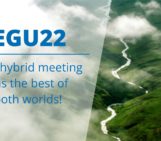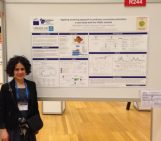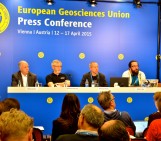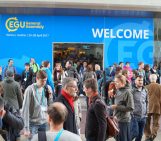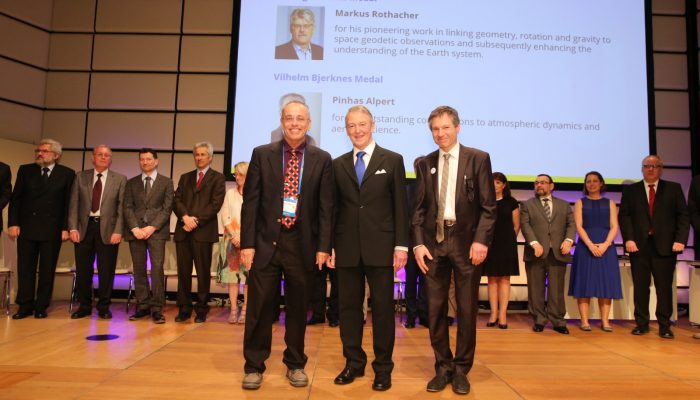
GeoTalk interviews usually feature the work of early career researchers, but this month we deviate from the standard format to speak to Pinhas Alpert, professor in geophysics and planetary sciences at Tel Aviv University and recipient of the 2018 Vilhelm Bjerknes Medal. Alpert was awarded for his outstanding contributions to atmospheric dynamics and aerosol science. Here we talk to him about his career, research, and life lessons he has learned as a scientist.
Thank you for talking to us today! Could you introduce yourself and tell us a little more about your career path?
I was born in Jerusalem, Israel on 28 Sept 1949. I received my BSc (Physics, Math & Computers) and MSc (Physics) as well as my Phd (Meteorology) at the Hebrew University of Jerusalem (1980; supervised by late Prof. Yehuda Neumann, Head of the Department of Meteorology).
Then I did my post-doc studies at Harvard University (US) with Professor Richard Lindzen (1980-1982) and got a position at Tel Aviv University in 1982.
I served as the Head of the Porter School of Environmental Studies, Tel-Aviv University, Israel, from 2008 to 2013, following three years as Head of the Department of Geophysics and Planetary Sciences also at Tel Aviv University.
My research focuses on atmospheric dynamics, climate, numerical methods, limited area modeling, aerosol dynamics and climate change. As part of my PhD, I built an atmospheric model, which is used in Belgium (LLN) and Finland (UH) for research.
I’ve published three books, and I am the co-author of more than 347 articles (240 peer-reviewed; 107 in books).
Some more recent work includes developing with my colleagues a novel way for monitoring rainfall using cellular network data. From this method we were able to create a new kind of advanced flood warning system.
I also developed a novel Factor Separation Method in numerical simulations. This methodology allows researchers to calculate atmospheric synergies, and has been adapted by many groups worldwide.
I established and head the Israel Space Agency Middle East Interactive Data Archive (ISA-MEIDA). Currently it is called the Israeli Atmospheric and Climatic Data Center (IACDC), which provides easy access to geophysical data from Israel and across the globe. I served as co-director of the GLOWA-Jordan River BMBF/MOS project to study the water vulnerability in the E. Mediterranean and also served as the Israel representative to the IPCC Third Assessment Report Working Group 1.
In addition to my research projects and positions I have supervised 42 Master students and 23 Doctoral students; some of them have become professors themselves in universities in Israel and abroad.
My current group consists of nine students as well as four post-docs and researchers.
I married my wife Rachel (RN) in 1971 and we have eight children and sweet grandchildren (not to count).
This year you received the 2018 Vilhelm Bjerknes Medal for your outstanding contributions to atmospheric dynamics and aerosol science, most notably your involvement with the Factor Separation Method and novel monitoring systems.
For those readers who may not be so familiar with your work, could you give us a quick summary of your research contributions and why it’s important?
The Factor Separation Method, first introduced in 1993, allowed scientists to compute the separation of synergies (or interactions or non-linear processes) among several factors for the first time in a quantitative approach.
This allowed researchers to compare for the first time different factors which contribute to some important processes like: heavy rainfall, floods, cyclone deepening, and model errors. The methods have now been applied in many areas of research, including environmental studies, paleoclimatology, limnology, regional climate change, rainfall analysis, cloud modelling, pollution, crop growth, and forecasting.
As to our novel method for monitoring atmospheric moisture: science today does not really know well enough how rainfall or moisture are distributed in the atmosphere.
This is true for all the world but it is particularly so over semi-arid or mountainous regions. For instance over Israel, a semi-arid region, we have about 100 rain gauges, while data from three cellular companies provide us with about 7000 cellular links from which we can calculate distribution of rain in real-time. Many severe flood events particularly over the semi-arid area of S. Israel have not been monitored at all by the classical approached including rain gauges and radar.
My colleagues and I developed a way to monitor such atmospheric conditions that taps into cellular communication networks (the network that lets us use our mobile phones for example). These networks are highly sensitive to the effects of weather phenomena and are widely spread across the world. By using data recorded by cellular communication providers, we found that these networks can provide important information on dangerous weather conditions.
For example, in one study published in the Bulletin of the American Meteorological Society we demonstrated that the technique could be used to monitor dense fog events. This is very important since there are no alternative methods to monitor fog on roads and highways, and furthermore they contribute to hazardous weather in which often hundreds of cars may be involved.
At the 2018 General Assembly, you gave a medal lecture on your personal perspective on the evolution of atmospheric research over time. What are some of the biggest lessons you have learned as a researcher?
My take-away messages were:
It seems impossible to predict which research will become a scientific breakthrough because,
- the message from your research came too early. For example, the Italian scientist Amedeo Avogadro first proposed the existence of a constant number of molecules in each kilomole of gas and calculated this number (6.022×1023). However, he was ridiculed for it, and only after he passed away was it accepted by the scientific community. Now every student must learn the Avogadro number in any basic thermodynamics course.
- the message was not clear or strong enough: When we are sure about our finding we must be strong in our statements and not too modest. Otherwise, the scientific community assumes that what we claim in our article is only a conjencture.
- the message was not given the right exposure. For example, in 1778-9 the French scholar Pierre-Simon Laplace was the first to develop the mathematical terms the Coriolis Force, an important term in physics that explains air acceleration due to Earth’s rotation. However, it was until 60 years later that the French mathematician Gaspard-Gustave Coriolis gave these terms their physical meaning, i.e. that air-parcels in the Northern Hemisphere for instance turn to the right due to the Earth rotation. And, this was the main reason why these terms were called after Coriolis and not after Laplace.
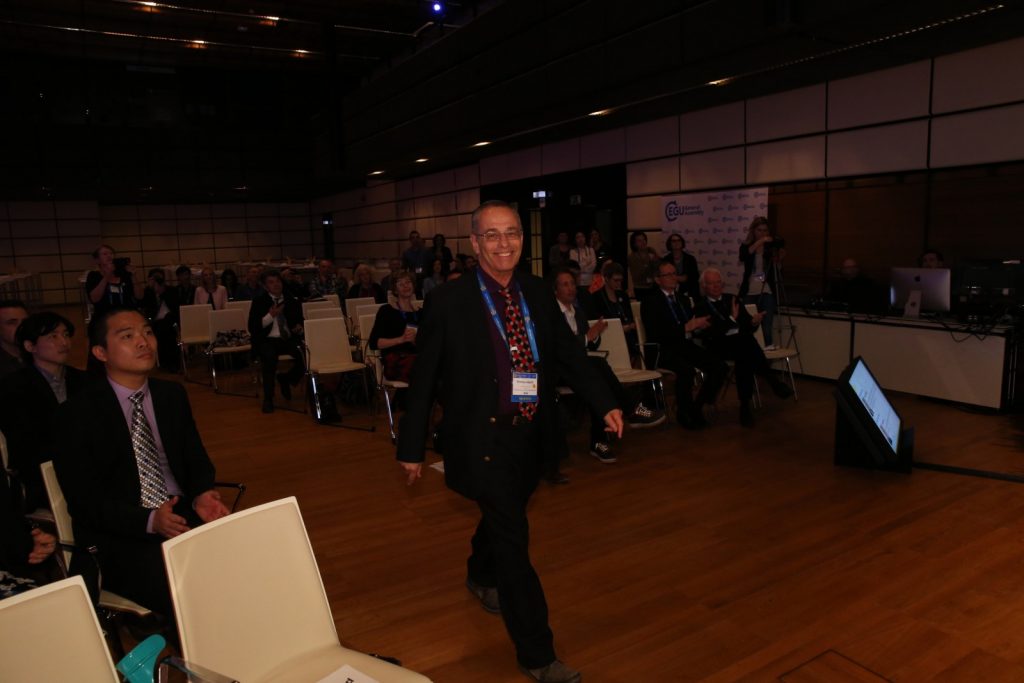
Pinhas Alpert receiving the Vilhelm Bjerknes Medal at the EGU Awards Ceremony during the 2018 General Assembly. (Credit: EGU/Foto Pfluegl)
I also discussed whether researchers should invest their time in a concentrated topic, or spread their interests. A common question in atmospheric research, which is particularly bothering early career researchers, is which of these primary three directions should they choose to follow: 1. theoretical approach; 2. analysis of observations and 3. Employ atmospheric models.
One option is to spread your efforts in two or three of these directions. while the more easy approach is often to focus on only one of these three routes. My take-away message during my talk was that, while it certainly more difficult to spread your research to 2-3 of these pathways, it is a very personal decision. There is no right answer that applies to everyone, and your choice depends very much on your personal preference. Remember to do the research that you love the most.
And the other most important take-away message for success is hard work. As Thomas Edison once said in an interview in 1929, “None of my inventions came by accident. I see a worthwhile need to be met and I make trial after trial until it comes. What it boils down to is one per cent inspiration and ninety-nine per cent perspiration.”
Recently, the IPCC released a special report on the consequences of global warming and the benefits of limiting warming to 1.5ºC above pre-industrial levels. You had mentioned that you served as the Israel representative to the IPCC Third Assessment Report Working Group I. What would you say were some key lessons learned from contributing to an IPCC report? Do you think it is important for researchers to be involved in the policy process?
One of the most amazing things I have learned from my participation there was how much politics and debate are involved there. There are a lot of negotiations between the representatives of the various countries, who sometimes spend hours on the wording of sentences.
Yes, it is very important for researchers to bring the messages from their work to decision makers. However, this should only be done when you are convinced that your results are important for the society. Hence, it is my opinion that early career scientists should focus more on promoting their science and be less involved in the policymaking process. Without a strong scientific backing, it may interfere with your research. Again, here as well, the decision should be strongly based on your personal feelings.
Interview by Olivia Trani, EGU Communications Officer


